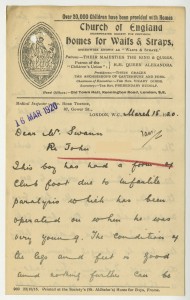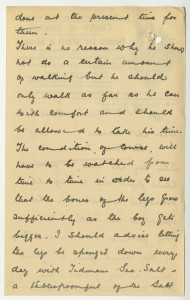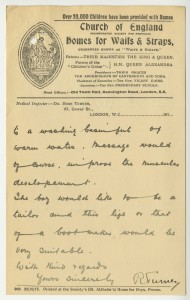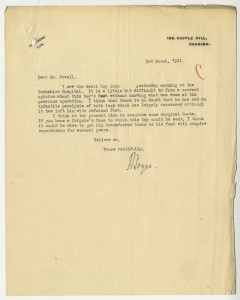This week I’ve been tracing lives through the Historic Hospital Admissions Registers Project (HHARP). The HHARP website contains a database of children who went to 19th Century children’s hospitals, and I wanted to see if any of those children were also in the care of The Children’s Society (known as the Waifs and Strays Society until 1946).
I found a few children in the database that could be matched to our case files here at The Children’s Society Archive, and today I’m going to tell you about one of them. John went to hospital with a deformity in his feet, which is described in John’s case file as both club feet and flat feet. He had had polio (also known as infantile paralysis) when he was younger, which is likely what had affected his feet.
In October 1911, the HHARP website lists John as entering Great Ormond Street Hospital in London. He was four years old and had been living at the Home for Sick Children in Battledown, Gloucestershire (this was a home that wasn’t operated by The Children’s Society). John stayed in hospital for about two months to have treatment for his feet.
While in hospital, an application was made for John to enter the care of The Children’s Society. It appears that the whereabouts of John’s parents and family was unknown. They had last been heard of in Winchcombe in Gloucestershire but they hadn’t been in contact while John was in the Battledown children’s home, and it had been assumed that the family had abandoned him.
John was discharged back to the Battledown home in December, and was described as “cured”. One month later, in January 1912, John re-entered Great Ormond Street Hospital in order to have more treatment for his feet. This time he was in hospital for just two days and was discharged back to Battledown with his condition described as “relieved”. In one of his two hospital stays, it seems that John had undergone an operation on his feet. As he was still recuperating from the surgery, the application to The Children’s Society was put on hold for a while.
By August 1912, John was able to “walk splendidly”. His application to The Children’s Society was restarted and in October, aged 5, he went to live in The Children’s Society’s St Nicholas’ Orthopaedic Hospital and Special School in Pyrford, Surrey.
John stayed in this home for about a year and a half and then, in 1914, he went to live in a foster home in Frettenham, Norfolk, along with another boy from St Nicholas’ Home. At this point, John was seven years old and we know that he was attending the local school while he was in foster care. Correspondence in our case file for John tells us that he received a medical examination at school, and that a doctor from The Children’s Society also came to see him. One of the doctors prescribed special boots for John’s feet and the other prescribed exercises for John to do; we don’t know what exercises these were, but we do know that the boots cost 15 shillings, 10 shillings of which were donated by a local person in Frettenham.
For a number of years, there’s little medical information to be found in John’s case file. He stayed in foster care in Frettenham until 1920 when he was twelve years old. It was normal for children at the age of twelve to leave foster care and go live in a children’s home where they could begin to learn a trade. And so, at the age of twelve, John left Frettenham and went to Peckham Receiving Home for Boys in London, which was a home that boys normally stayed in temporarily before moving on to other children’s homes.
At Peckham Receiving Home, John was seen by a doctor, who recommended that he have hospital treatment for his ankle. For a second opinion, John was also seen by the doctor from The Children’s Society who’d gone to see him in Frettenham. Her response after seeing John is below:
March 15 1920
Dear Mr. Swann
Re John [surname]
This boy has had a form of
club foot due to infantile
paralysis which has been
operated on when he was
very young. The condition of
the legs and feet is good
and nothing further can be
done at the present time for
them.
There is no reason why he should
not do a certain amount
of walking but he should
be allowed to take his time.
The condition, of course, will
have to be watched from
time to time in order to see
that the bones of the legs grow
sufficiently as the boy gets
bigger. I should advise letting
the legs be sponged down every
day with Tidmans Sea-Salt –
a tablespoon of the salt
to a washing basinful of
warm water. Massage would
of course, improve the muscular
development.
The boy would like to be a
tailor and this life or that
of a boot maker, would be
very suitable.
With kind regards
Yours sincerely
R Turner
Dr Turner’s recommendations are wonderfully detailed. We see that she recommends massage for John’s legs, which seems like something a child could be prescribed today. She also recommends bathing John’s legs in a salt solution, which is a little more unusual. I’m not sure what the purpose of this salt-bathing would be; let me know in the comments if you have any ideas!
John stayed in Peckham Receiving Home while a place was found for him elsewhere. After a few months he went to St Andrew’s Home for Boys in Matlock, Derbyshire. However, after only three months there it was clear that St Andrew’s Home wasn’t well-equipped to look after a boy like John who had difficulty walking. As a result, John was sent back to Peckham Receiving Home.
Once again enquiries were made as to a suitable children’s home for John. John wanted to become a tailor, and so he was sent to St Benet’s Home for Boys at Emmer Green, Berkshire, where they taught tailoring skills.
Sadly, however, it seems that this home wasn’t suitable for John either. After only a month, John was seen by a surgeon at Berkshire Hospital in Reading, who had the following to say (click the image for a larger version):
The surgeon recommended that John have special boots again, and suggested that John be sent to a home that would provide him with specialist medical supervision. Once again, we find that the home John was currently living in was not equipped to look after boys with conditions like his.
And so, for the third time, John was sent to Peckham Receiving Home. He was there for only a short while this time before being sent to St Martin’s Orthopaedic Hospital and Special School in Pyrford, Surrey. This home was next door to St Nicholas’ Home which John had lived in when he had first entered the care of The Children’s Society. Like St Nicholas’ Home, St Martin’s also specialised in looking after children with orthopaedic conditions; St Martin’s, however, took in older boys and often taught them trades such as tailoring.
Finally, John was able to settle down in a home for a decent period of time. He stayed at St Martin’s for three years until 1924 when he was seventeen years old. By 1924 John’s feet were described as cured and a report states that he had completed his training in tailoring. For a job, however, John had since decided that he would rather work as a servant than as a tailor.
There was initially some difficulty in finding John a job. He had a speech impediment which led some potential employers to turn him down because they didn’t think him suitable for answering the door to visitors.
In order to increase his job prospects, John returned to Peckham Receiving Home, as this home was often used as a temporary home for boys looking for work. It was successful. After just two days in Peckham, John went to work as a hall boy in Pimlico in London, earning seven shillings and sixpence a week.
John stayed in this job for about a month and a half. We don’t know why he left, but he soon went to another job on a farm in Plumpton, Sussex, earning six shillings a week. John started this job in July 1924 and stayed there until Christmas 1924 when he returned to Peckham Receiving Home for a brief holiday. However, when in Peckham, John said that he didn’t want to go back to the farm in Plumpton but instead wanted to go live with his father.
John’s father had just sent John a letter. After a number of enquiries over the previous year, The Children’s Society had finally tracked down John’s family. They found that John’s father and siblings had moved away from Winchcombe in Gloucestershire and had gone to live in Llantwit Fardre in Glamorgan. John’s mother had died, leaving John’s father and John’s eldest sister to look after John’s five other siblings. They were struggling to get by, and when their house was condemned as unfit for habitation, John’s father had become homeless and John’s siblings had been sent to a children’s home nearby. Previously, when John had been struggling to find work, it was suggested that he could go live with his father, but the local vicar of Llantwit Fardre warned that “It would be fatal to send the boy home under the circumstances”.
It is understandable, then, that when John returned to Peckham in Christmas 1924 and said that he wanted to go live with his father, The Children’s Society didn’t let him go straight away.
Instead, in January 1925, John went to work in another job as an under butler in a college in Chelsea, London, earning six shillings a week. Meanwhile, The Children’s Society wrote to the vicar of Llantwit Fardre to see if John’s father’s circumstances had improved and if it would be possible for John to go live with him.
Unfortunately, John’s case file ends there so we don’t know what happened next. Did John stay working as an under butler in Chelsea or did he go to live with his father in Llantwit Fardre? Presumably John thought that he’d be able to help his father earn money to support the family, but it wouldn’t have been easy if they had nowhere to live. And why did John’s family never contact him when he was first put into a children’s home all those years ago? Were their circumstances as dire in 1911 as they were in 1924? It seems that John’s story still has more to tell.
Despite the gaps in our information, what have we been able to learn? Firstly we have seen just how fascinating it is to link our records to those of Great Ormond Street Hospital using the HHARP website. We can follow John’s treatment from surgery in hospital through to orthopaedic boots, to massage and to bathing in salt water. By the end of his file in 1925, it seems that all the treatments had paid off, with John gaining enough mobility to work as a servant.
What seems most clear to me though, is just how difficult it must have been for John and for other disabled children in similar situations. With John’s difficulty walking, it seems that there were many children’s homes which just weren’t able or weren’t willing to look after him. This led to a long period of being shuttled back and forth from one children’s home to another, which for John must have been as disheartening as it was unsettling. Then, when looking for work a few years later, we find that John’s speech impediment was another thing that caused people to discriminate against him.
John’s story is not an easy one to read. It does, however, give us an insight into social attitudes at the time.
Find out more
Have a search of the Historic Hospital Admissions Registers Project (HHARP) website for yourself and discover the children’s stories there.




